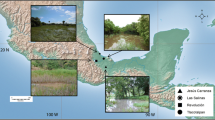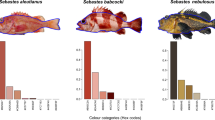Abstract
Validity of the largest size accounts is not well documented and most published accounts of body coloration describe dead specimens lacking scales instead of the color of freshly caught opah. Maximum length is at least 163 cm fork length and maximum weight about 89 kg. The body color of fresh specimens is vermilion with white spots.


Similar content being viewed by others
References
Bane GW Jr (1965) The opah (Lampris regius) from Puerto Rico. Carib J Sci 5:63–66
Collette BB (2003) Family Lampridae. In: Carpenter KE (ed) FAO species identification guide for fishery purposes. The living marine resources of the western Central Atlantic. Vol 2. Bony fishes part 1 (Acipenseridae to Grammatidae). American Society of Ichthyologists and Herpetologists Special Publication No 5 and FAO, Rome, p 952
Collette BB (2010) Chapter 2. Reproduction and development in epipelagic fishes. In: Cole KS (ed) Reproduction and sexuality in marine fishes: patterns and processes. University of California Press, Berkeley, pp 21–63
Duhamel G, Gasco N, Davaine P (2005) Poissons des îles Kerguelen et Crozet, guide régional de l’océan Austral. Collection Patrimoines Naturels 63, Muséum National d’Histoire Naturelle, Paris, 419 pp
Gilchrist JDF (1904) Descriptions of new South African fishes. Marine investigations in South Africa 3:1–16
Gottfried MD, Fordyce RE, Rust S (2006) Megalampris keyesi, a giant moonfish (Teleostei, Lampridiformes) from the Late Oligocene of New Zealand. J Vert Paleo 26:544–551
Grosvenor MB, (ed) (1965) Wondrous world of fishes. National Geographic Society, Washington, D.C.
Grosvenor MB (ed) (1969) Wondrous world of fishes. New enlarged edition. National Geographic Society, Washington, D.C.
Gudger EW (1930) The opah or moonfish, Lampris luna, on the eastern coast of North America. Amer Nat 64:168–178
Gudger EW (1931) The opah or moonfish, Lampris luna, on the coasts of California and of Hawaii. Amer Nat 65:531–540
Hart JL (1973) Pacific fishes of Canada. Fisheries Research Board of Canada, Bull No 180, Ottawa
Heemstra PC (1986) Family No. 117: Lampridae. In: Smith MM, Heemstra PC (eds) Smiths’ sea fishes. Macmillan South Africa, Johannesburg, p 398
IGFA. 2011. IGFA world record game fishes. International Game Fish Association. Dania Beach, Florida
Jordan DS (1905) A guide to the study of fishes. Henry Holt & Co., New York
Jordan DS (1920) An ancient moonfish. Sci Monthly 11:470–473
Jordan DS, Evermann BW (1905a) American food and game fishes. Doubleday, Page & Co., New York
Jordan DS, Evermann BW (1905b) The shore fishes of the Hawaiian Islands with a general account of the fish fauna. Bull US Fish Comm 23:1–574
Jordan DS, Gilbert JZ (1919) Fossil fishes of southern California. II. Fossil fishes of the (Miocene) Monterey formations of southern California. Leland Stanford Junior Univ Publ Univ Ser:12–60
Jordan DS, Jordan EK (1922) A list of the fishes of Hawaii, with notes and descriptions of new species. Mem Carnegie Mus 10:1–92
Klawe WL (1966) Observations on the opah, Lampris regius (Bonnaterre). Nature 210:965–966
Klein-MacPhee G (2002) Opahs. Family Lampridae. In: Collette BB, Klein-MacPhee G (eds), Bigelow and Schroeder’s fishes of the Gulf of Maine, 3rd ed. Smithsonian Institution Press, Washington, D.C., pp 205–207
Leim AH, Scott WB (1966) Fishes of the Atlantic coast of Canada. Fisheries Research Board of Canada, Bull No 155, Ottawa
McKenzie RA, Tibbo SN (1963) An occurrence of opah, Lampris regius (Bonnaterre), in the northwest Atlantic. J Fish Res Bd Canada 20:1097–1099
Mecklenburg CW, Mecklenburg TA, Thorsteinson LK (2002) Fishes of Alaska. American Fisheries Society, Bethesda, Maryland
NOAA. 2011. Fish Watch. Opah. http://www.nmfs.noaa.gov/fishwatch/species/opah.htm
Norman JR, Fraser FC (1937) Giant fishes, whales and dolphins. Putnam, London
Norman JR, Fraser FC (1949) Field book of giant fishes. G.P. Putnam’s Sons, New York
Oelschläger HA (1981) Family Lamprididae. In: Fischer W, Bianchi G, Scott WB (eds) FAO species identification sheets for fishery purposes. Eastern Central Atlantic; fishing areas 34, 47 (in part). Vol 2. Department of Fisheries and Oceans, Canada and FAO, Rome, 2 pp
Olney JE (1999) Lamprididae, opahs. In Carpenter, KE, Niem VH (eds) FAO species identification guide for fishery purposes. The living marine resources of the western Central Pacific. Vol 3. FAO, Rome, p 1968
Palmer G (1986) Lamprididae. In Whitehead PJP, Bauchot ML, Hureau JC, Nielsen J, Tortonese E (eds) Fishes of the north-eastern Atlantic and the Mediterranean. Vol 2. UNESCO, Paris, pp 725–726
Palmer G, Oelschläger HA (1976) Use of the name Lampris guttatus (Brünnich, 1788) in preference to Lampris regius (Bonnaterre, 1788) for the opah. Copeia 1976:366–367
Parin NV, Kukuyev YI (1983) Establishment of validity of Lampris immaculata Gilchrist and the geographical distribution of Lampridae. J Ichthyol 23:1–12
Pennant T (1776) British zoology, 4th ed. Vol III. Class III. Reptiles, IV. Fish. London
Pepperell J (2010) Fishes of the open ocean. University of Chicago Press, Chicago
Rosenblatt RH, Johnson GD (1976) Anatomical considerations of pectoral swimming in opah, Lampris guttatus. Copeia 1976:367–370
Runcie RM, Dewar H, Hawn DR, Franck LR, Dickson KA (2009) Evidence for cranial endothermy in the opah (Lampris guttatus). J Exper Biol 212:461–470
Thompson WF (1924) Notes from the State Fisheries Laboratory. San Pedro rarities. Calif Fish Game 10:143–144
Tinker SP (1944) Hawaiian fishes. Tongg Publishing Co. Honolulu, Hawaii
Tinker SP (1982) Fishes of Hawaii. Hawaiian Service Inc., Honolulu, Hawaii
Wheeler A (1969) The fishes of the British Isles and north-west Europe. Michigan State University Press, East Lansing, Michigan
Acknowledgments
We thank C.Y. Tokita, W.A. Walsh, B.C. Mundy and M.P. Seki of the Pacific Islands Fisheries Science Center for their data and editorial assistance, R.H. Rosenblatt of the Scripps Institution of Oceanography, J.G. Pepperell of Pepperell Research & Consulting Pty Ltd., and R.N. Lea of the California Academy of Sciences, Department of Ichthyology for their reviews and comments, G. Duhamel and A. Prudor for Fig. 2, and G.D. Johnson and V.G. Springer of the National Museum of Natural History for their help interpreting the opah figure included in Jordan’s papers.
Author information
Authors and Affiliations
Corresponding author
About this article
Cite this article
Hawn, D.R., Collette, B.B. What are the maximum size and live body coloration of opah (Teleostei: Lampridae: Lampris species)?. Ichthyol Res 59, 272–275 (2012). https://doi.org/10.1007/s10228-012-0277-z
Received:
Revised:
Accepted:
Published:
Issue Date:
DOI: https://doi.org/10.1007/s10228-012-0277-z




